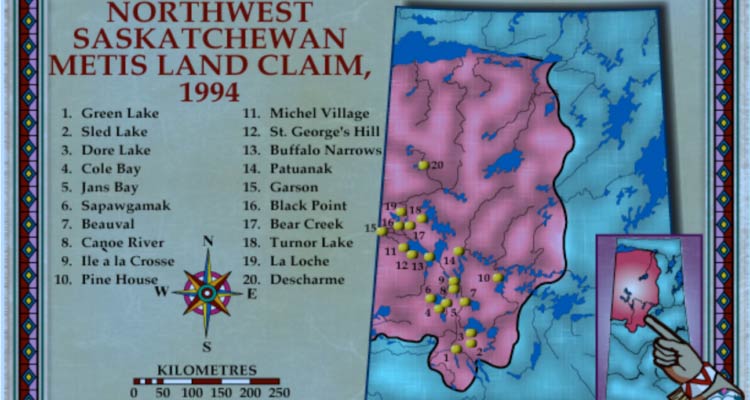
By Derek Cornet
Plaintiffs of the 1994 Northwest Saskatchewan Métis Land Claim are hopeful the recent accord signed with the federal government will provide closure.
“We’ll continue living here, but everyone seems to be getting everything out of our territory except us,” stated Max Morin of Ile-a-la Crosse, who was a plaintiff in the statement of claim filed against the government of Canada more than two decades ago. “I’m hoping the federal government will deal with us with an out-of-court settlement. In good faith, they should sit down with us to see what we can come up with.”
While Morin has since bowed out of politics, at the time he was a regional area director for the Métis Nation – Saskatchewan (MN-S). In May of 1994, he and several others brought the claim to the Court of Queen’s Bench in Saskatoon. The statement sought three declarations: the aboriginal title to the lands and resources of the Métis of that region was not extinguished by the 1906 scrip distribution; the aboriginal right to hunt, trap, fish and gather was not extinguished; along with the inherent right of self-government.
The region covered in the claim is a wide swath of land extending south of Green Lake to the southern shore of Lake Athabasca. Twenty Métis communities are represented and the MN-S chose to focus on the region for several reasons. When scrip was distributed in 1906, the land in which they lived was unavailable at the time because the area had not yet been surveyed. The MN-S also believed, because the region was smaller, less research would be needed, and, therefore, it would not cost as much as a bigger claim.
“There was scrip issued in 1906 in Ile-a-la Crosse and La Loche, and people never got any land because of speculators moving around with the commissioners,” Morin explained. “Money was of no value to people in 1906 – people were still dealing with furs. Some of the old timers who got money – some got silver dollars – they threw them in the lake because it had no value to them.”
Since the Northwest had not yet been surveyed, he said those who did take up the offer of land were given parcels in far away places in southern Saskatchewan and Alberta. Morin claims others who couldn’t sign their name for scrip or read, were often the victims of fraud and theft. For those reasons, the plaintiffs believe the scrip process was fraudulent and unjust.
After the claim was filed in 1994, both the federal and provincial governments filed statements of defence claiming Métis rights were extinguished in 1906 by the scrip process. The plaintiffs also hit a dead end shortly after when they went through court.
“It was a federal lawyer who stalled everything,” Morin recalled. “We were doing a lot of research out of the University of Saskatchewan, then at the University of Alberta in Edmonton. What happened is, when we filed our claim, they wanted disclosure for everything – they wanted all the information we had.”
Morin said, the plaintiffs had concerns about handing over their research, considering it would be needed to build a court case when the time came. He also claimed they ran into trouble while trying to access documents at the University of Alberta, as people there were claiming it as intellectual property.
“It stalled and the judge said, until we provide more information, they’re going to put it on hold,” Morin commented.
Meanwhile, incumbent MN-S vice-president Gerald Morin – of no relation to Max Morin – also believes a deal to resolve the claim is forthcoming. He’s originally from Green Lake – a Métis community that secured a settlement on public lands in 1944 – and said, when a regional agreement is struck, it will respect aboriginal rights entrenched in the Canadian Constitution.
“It will address nationhood, recognition and respect of our nation, the implementation of rights, reconciliation, and essentially achieve the aspirations of the Métis Nation which has been at the core of our struggle throughout all these years.”
Gerald Morin went on to say a memorandum of understanding to begin such an agreement could be signed in the upcoming weeks. He noted, the Manitoba Métis Federation (MMF) has already agreed to one with the federal government, which includes the establishment of a negotiating table to address outstanding issues like Section 31 of the Manitoba Act.
The Act – which brought the province into confederation in 1870 – promised the Métis people would gain title to the land they already farmed, as well as an additional 1.4 million acres of land for the use of their children. The Métis there also believe the distribution of scrip wasn’t right, as it failed to create the homeland they desired. Currently, Morin stated the MMF is seeking to settle the claim with the federal government, along with signing a modern day treaty with them.
“They’re further ahead of anyone else,” he mentioned. “It’s a two stage process. The MOU commits the government to enter into a more formal framework agreement.”